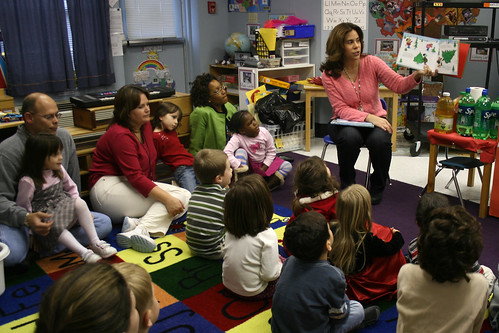When a parent visits a daycare, top of their minds is what kind of activities their children will be doing. A typical visit includes a description of the day, from play time, to nap time, to out door time. Most day cares proudly announce that they have no or very little screen time - be it television or computers.
But suddenly, the "critical thinkers" in the education policy world think we should be infusing and transforming our schools, including our primary classrooms, with endless numbers of screens and gadgets. Class sets of iPads, BYOD (bring your own device), blended learning...there is a never ending push for more technology in teaching.
Just today I had a look at a slideshow from Brian Kuhn, an IT Manager of School District 43. The show is entitled Brittania Elementary Education Technology Ideas (http://www.slideshare.net/bkuhn/britannia-elementary-educational-technology-ideas-nov2012) and displays the so-called wonders of using digital cameras, smart phones, ipads and laptops in elementary school. While no doubt many of the activities presented are fun, engaging, and involve some learning, nowhere was there a critical look at a most basic question: how much technology is appropriate for children? what are the downsides? at what age? and critically, how much is too much?
Or, to put it visually, do we want schools with more of this:

(http://www.flickr.com/photos/56155476@N08/6659978347/)
or with more of this:

(http://www.flickr.com/photos/wwworks/3120816179/sizes/m/in/photostream/)
Far away from the education policy makers, other fields of study - notably pediatrics and child psychology - are making some very relevant critiques of the dangers of screen time, particularly for children and teenagers.
Dr. Larry Rosen, writing for Psychology Today, describes a recent study of students:
"Recently my research team observed nearly 300 middle school, high school and university students studying something important for a mere 15 minutes in their natural environments. We were interested in whether they could maintain focus and, if not, what might be distracting them. Every minute we noted exactly what they were doing, whether they were studying, if they were texting or listening to music or watching television in the background, and if they had a computer screen in front of them and what websites were being visited.
The results were startling. First, these students were only able to focus and stay on task for an average of three minutes at a time and nearly all of their distractions came from technology. [By the way, other researchers have found similar attention spans with computer programmers and medical students.] The major culprit: their smartphone and their laptop were providing constant interruptions. We also looked at whether these distractors might predict who was a better student. Not surprisingly those who stayed on task longer and had study strategies were better students. The worst students were those who consumed more media each day and had a preference for working on several tasks at the same time and switching back and forth between them. One additional result stunned us: If they checked Facebook just once during the 15-minute study period they were worse students. It didn’t matter how many times they looked at Facebook; once was enough." (http://www.psychologytoday.com/blog/rewired-the-psychology-technology/201204/attention-alert-study-distraction-reveals-some-surpris)
Dr. Marilyn Price-Mitchell, a developmental psychologist, writes on her web site about the effects on children of over stimulation from television:
"In 1970, the average age at which children watched television was four years old. Today, the average age is four months. The typical child before the age of five is watching 4 ½ hours of television per day, 40% of their waking hours! Recent studies have linked television to the over-stimulation of an infant’s brain, leading to the development of Attention-Deficit/Hyperactivity Disorder (ADHD) in young children."
(http://rootsofaction.com/blog/are-we-over-stimulating-young-children-dimitri-christakis/)
She is referring to studies by Dr. Dimitri Christakis, MD, on the effect of television viewing on children. Dr. Christakis has produced a TED talk on the topic of media and children, and suggests parents need to ensure their children are on a "media diet".
Interestingly, school is one place where children currently escape from their gadgets and screens. But this could be set to change, without much public discussion.
This theme is also taken up by Dr. Stuart Shankar, a Canadian researcher involved in the study of self-regulation, who talks about the effects of stress and over stimulation:
"What we're seeing is a generation of children whose nervous system is essentially being overstimulated."
Reasons included emotional and physiological stressors such as changing marital patterns, parental stress, changes in extended family involvement, increased use of the television, video games and the internet, and exposure to damaging themes via marketing and the media.
"We're concerned about the dramatic increase in television viewing, which is a physiological stressor because so much of the brain's energy is used on visual processing," Dr Shanker says.
(http://au.news.yahoo.com/thewest/lifestyle/a/-/article/13946118/childrens-stress-levels-soar/)
The corporations who stand to make substantial profits from technology in education have spent a decade promoting the "edtech" business. They are single minded - they want as much technology in schools as possible. And they are on the cusp of getting what they want in growing numbers of jurisdictions all over the world. Layers of education policy makers and bureaucrats now mindlessly push technology without any discussion about potential drawbacks or health concerns, but rather just the "more is better" mantra.
But suddenly, the "critical thinkers" in the education policy world think we should be infusing and transforming our schools, including our primary classrooms, with endless numbers of screens and gadgets. Class sets of iPads, BYOD (bring your own device), blended learning...there is a never ending push for more technology in teaching.
Just today I had a look at a slideshow from Brian Kuhn, an IT Manager of School District 43. The show is entitled Brittania Elementary Education Technology Ideas (http://www.slideshare.net/bkuhn/britannia-elementary-educational-technology-ideas-nov2012) and displays the so-called wonders of using digital cameras, smart phones, ipads and laptops in elementary school. While no doubt many of the activities presented are fun, engaging, and involve some learning, nowhere was there a critical look at a most basic question: how much technology is appropriate for children? what are the downsides? at what age? and critically, how much is too much?
Or, to put it visually, do we want schools with more of this:

(http://www.flickr.com/photos/56155476@N08/6659978347/)
or with more of this:

(http://www.flickr.com/photos/wwworks/3120816179/sizes/m/in/photostream/)
Far away from the education policy makers, other fields of study - notably pediatrics and child psychology - are making some very relevant critiques of the dangers of screen time, particularly for children and teenagers.
Dr. Larry Rosen, writing for Psychology Today, describes a recent study of students:
"Recently my research team observed nearly 300 middle school, high school and university students studying something important for a mere 15 minutes in their natural environments. We were interested in whether they could maintain focus and, if not, what might be distracting them. Every minute we noted exactly what they were doing, whether they were studying, if they were texting or listening to music or watching television in the background, and if they had a computer screen in front of them and what websites were being visited.
The results were startling. First, these students were only able to focus and stay on task for an average of three minutes at a time and nearly all of their distractions came from technology. [By the way, other researchers have found similar attention spans with computer programmers and medical students.] The major culprit: their smartphone and their laptop were providing constant interruptions. We also looked at whether these distractors might predict who was a better student. Not surprisingly those who stayed on task longer and had study strategies were better students. The worst students were those who consumed more media each day and had a preference for working on several tasks at the same time and switching back and forth between them. One additional result stunned us: If they checked Facebook just once during the 15-minute study period they were worse students. It didn’t matter how many times they looked at Facebook; once was enough." (http://www.psychologytoday.com/blog/rewired-the-psychology-technology/201204/attention-alert-study-distraction-reveals-some-surpris)
Dr. Marilyn Price-Mitchell, a developmental psychologist, writes on her web site about the effects on children of over stimulation from television:
"In 1970, the average age at which children watched television was four years old. Today, the average age is four months. The typical child before the age of five is watching 4 ½ hours of television per day, 40% of their waking hours! Recent studies have linked television to the over-stimulation of an infant’s brain, leading to the development of Attention-Deficit/Hyperactivity Disorder (ADHD) in young children."
(http://rootsofaction.com/blog/are-we-over-stimulating-young-children-dimitri-christakis/)
She is referring to studies by Dr. Dimitri Christakis, MD, on the effect of television viewing on children. Dr. Christakis has produced a TED talk on the topic of media and children, and suggests parents need to ensure their children are on a "media diet".
Interestingly, school is one place where children currently escape from their gadgets and screens. But this could be set to change, without much public discussion.
This theme is also taken up by Dr. Stuart Shankar, a Canadian researcher involved in the study of self-regulation, who talks about the effects of stress and over stimulation:
"What we're seeing is a generation of children whose nervous system is essentially being overstimulated."
Reasons included emotional and physiological stressors such as changing marital patterns, parental stress, changes in extended family involvement, increased use of the television, video games and the internet, and exposure to damaging themes via marketing and the media.
"We're concerned about the dramatic increase in television viewing, which is a physiological stressor because so much of the brain's energy is used on visual processing," Dr Shanker says.
(http://au.news.yahoo.com/thewest/lifestyle/a/-/article/13946118/childrens-stress-levels-soar/)
The corporations who stand to make substantial profits from technology in education have spent a decade promoting the "edtech" business. They are single minded - they want as much technology in schools as possible. And they are on the cusp of getting what they want in growing numbers of jurisdictions all over the world. Layers of education policy makers and bureaucrats now mindlessly push technology without any discussion about potential drawbacks or health concerns, but rather just the "more is better" mantra.
.JPG)
